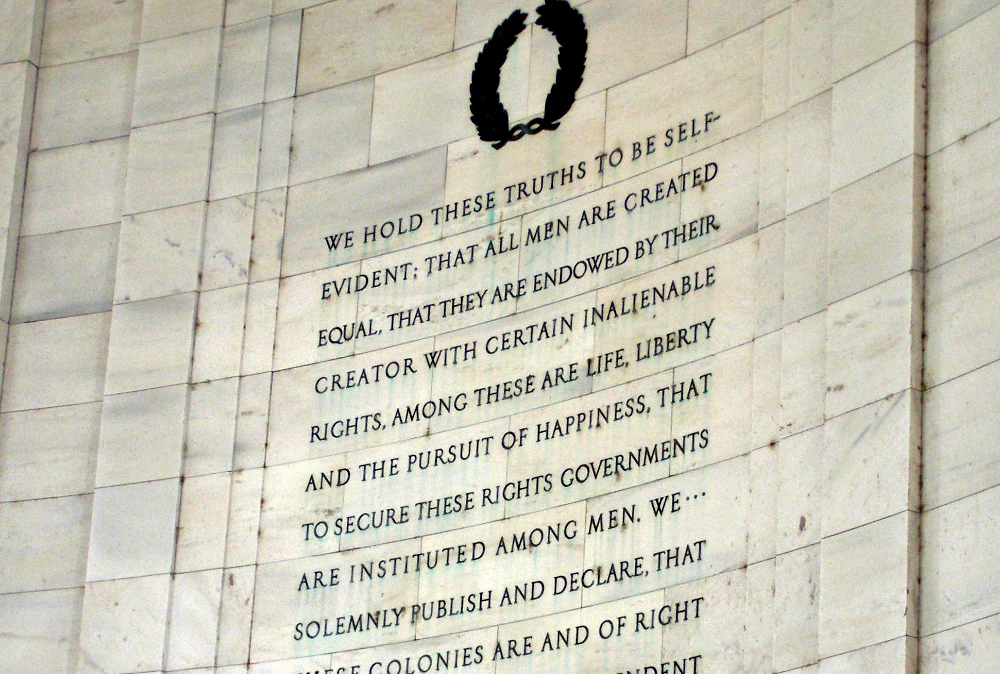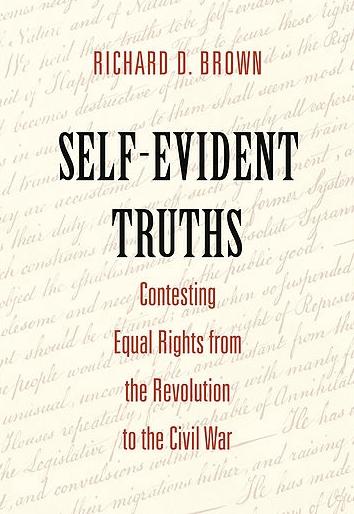
The words of the Declaration of Independence are seen in the interior of the Jefferson Memorial in Washington, D.C. (Flickr/Sean Hayford Oleary)
Part 1 of 2
During the confirmation hearings for Brett Kavanaugh, I ran two columns (here and here) that examined the development of the legal theory known as "originalism," developments that bring the theory far from any original intent of the Framers. Some liberal scholars have questioned if it is even theoretically possible to determine "the intent of the Framers." After all, different Framers wanted different things from their common handiwork, which represents a series of compromises and even a couple of cans kicked down the road.
And because the late 18th and early 19th centuries were times of exciting political change and clashing ideological inclinations, individual Framers changed their views over time. How can one simplistically invoke "the intent of the Framers" as any kind of guiding light for constitutional interpretation?
Simplistically, no, but by attending carefully to the complex history of the founding era, one can discern themes and commonalities, confront the fraught issues they confronted with the benefit of knowledge since gained, and wrestle as they wrestled with values that are in some sense incommensurable. All this can lead a scholar or citizen to gain a better and deeper appreciation for this experiment in democracy that is ours still, and of the men who launched it almost 250 years ago.

A book published last year joins the pantheon of scholarly works on the early republic that any truly informed citizen must have in her library. Self-Evident Truths: Contesting Equal Rights From the Revolution to the Civil War, by Richard Brown, begins with the most famous phrase in political history: "We hold these truths to be self-evident, that all men are created equal, that they are endowed by their Creator with certain unalienable rights, that among these are Life, Liberty and the Pursuit of Happiness." Brown shows that while the truths might have been "self-evident," how they were to be applied to life in the young nation and how conflicts among the truths were to be adjudicated were not self-evident at all, that "the meaning of the words and their underlying principle, Americans would learn, were neither simple nor transparent."
Brown confronts at the outset the charge, self-evident in its ways, that the founders were hypocrites, many of them slaveholders, none of them interested in recognizing the equality of women or blacks or Native peoples.
"It is possible that the language of the Declaration was propaganda," Brown writes. "Certainly it was an explicitly political text intended to arouse popular support. But, for it to succeed, the ideas it invoked must have been meaningful — even inspiring — for many Americans. Viewing the Congress of gentlemen with full-blown skepticism could be a mistake. Maybe their political machinations were propelled not only by ambition and selfish interests but by ideas and ideals as well."
Brown makes clear that he thinks a commitment to natural equality was part and parcel of the founders' idealism, even if it was not the entire story. Even before we leave the preface, we are alerted to how impossible it is to appropriate virtue ethics to originalism: "This book contends that the Declaration's fateful phrase was not merely high-flown rhetoric. For many Revolutionaries it expressed their profound commitment to a new political and social contract." Contractualism is not part of the legacy of Aristotle and Aquinas.
But, again, it is the historian's care to avoid sweeping judgments in the manner of today's legal theorists that most impresses, because Brown almost immediately points to a major qualifying difficulty with Thomas Jefferson's famous words. Brown writes:
The distance between their declaration and its fulfillment was bound to be arduous and conflict-ridden. Moreover, Americans' all-but-unanimous commitment to private property — and to its heritability across the generations — provided a structural impediment to the full realization of equal rights that few were ready to confront, prompting William Dean Howells to remark, in Impressions and Experiences (1896), that "inequality is as dear to the American heart as liberty itself."
From our earliest years as a nation even unto today, private property has been both an essential guarantor of personal liberty and an impediment to that natural equality held forth as an ideal by our founders.
Natural equality was not the language of the American colonists as tensions arose between themselves and the mother country. They appealed, instead, to their rights as Englishmen when they fought against the Sugar Act and the Stamp Act. Only in the years 1772-75 do universal appeals to natural equality enter into the lexicon of revolutionary ferment.
Advertisement
Even then, their view of natural equality is blinkered by prejudice. "Their understanding of liberty of conscience excluded 'tyrannical' Roman Catholicism and accepted discrimination, even among Protestants; but they believed that something called religious freedom was a natural right," Brown writes.
The careful historian, unlike the polemic legal scholar, does not squeeze facts into preordained categories nor ignore some to achieve a desired result. Look at these words, which nicely balance competing points of view:
In retrospect it is clear that the Declaration's great assertion of natural equality was partly tactical — Congress preferred a source above English law to justify separation — and partly an optimistic, forward-looking profession of faith that served the collective interest at a moment of soaring Revolutionary idealism. Congress's vote for this statement was unanimous; but actual beliefs about equality — religious, political, social, and what was called "race" — were both fluid and divided. Moreover, everyone recognized that the newly created United States government in 1776 would not and could not revise political and social institutions in the states.
And much of the book then turns to the way the states would wrestle with the aspiration to natural equality in society riven with inequalities.
For readers of this column, Brown's examination of how religious equality manifested itself in the years after the Revolution will be especially fascinating. I was familiar with the fact that my home state of Connecticut maintained the Congregational Church as the established church until 1818: The First Amendment's separation clause did not apply to the states. I had not realized how many other states had trouble figuring out how to navigate away from the traditional presumption that it was the duty of the state to support the church.
Brown explains, "The imperial conflict led American patriots to downplay their religious differences conspicuously. ... As such, the issue of religious equality was never central to the Patriot cause."
Moreover, the years of conflict witnessed immense changes in religious demography. In 1760, 60 percent of American colonists belonged to the two established churches, the Congregational or the Anglican. By 1790, when the first federal census was taken, that percentage had dropped to 30 percent. It was in this context that disestablishment at the state level commenced.
The process of disestablishment was uneven at best. "In New England the Revolutionary distinction between toleration and full-fledged religious freedom, the idea that religious equality was essential for complete freedom, met prolonged, vigorous resistance based on ideology and interest," Brown writes.
Yale's president Timothy Dwight warned his fellow Nutmeggers that "toleration was merely a mask for secularism," Brown writes. In Massachusetts, disestablishment was not achieved until 1833, when a referendum overwhelmingly voted to end taxpayer support for the church. In New Hampshire, a disestablishment law passed in 1819 but the state's constitution still required officeholders to be Protestants until 1876!
New York, home to the nation's first chief justice and chief anti-Catholic bigot as well, John Jay, was quick to adopt religious equality in its 1777 constitution. But Jay slipped in a provision requiring voters to swear that they owed no allegiance to any foreign prince, both civil and ecclesiastical. Thus, Catholics were effectively disenfranchised, despite the constitutional guarantee of religious freedom. It was not until 1806 that the word "ecclesiastical" was dropped and Catholics enjoyed equal rights.
Brown also notes that the "difference between religious liberty at the national and state levels is suggested by the contrast between the Enlightenment views of the first four presidents — none of whom was a converted Christian — and state religious restrictions on Catholics and Jews."
I do not think it is possible to disentangle Enlightenment views from "the intent of the founders" celebrated by the originalists. And the varied, halting road to disestablishment and religious freedom demands a certain avoidance of sweeping claims. Once these historical facts are acknowledged, projects that entail introducing Christian conceptions of virtue into the constitutional interpretation mix simply walk into a wall.
I shall conclude this review on Friday.
[Michael Sean Winters covers the nexus of religion and politics for NCR.]
Editor's note: Don't miss out on Michael Sean Winters' latest: Sign up to receive free newsletters and we'll notify you when he publishes new Distinctly Catholic columns.








